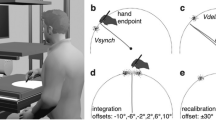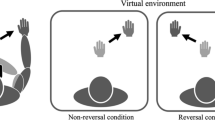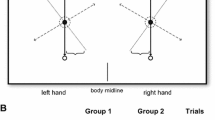Abstract
Integration of discrepant visual and proprioceptive action effects puts high demands on the human information processing system. The present study aimed to examine the integration mechanisms for the motor (Exp. 1) and visual modality (Exp. 2). According to theories of common coding, we assumed that visual as well as proprioceptive information is represented within the same cognitive domain and is therefore likely to affect each other (multisensory cross talk). Thus, apart from the often-confirmed visual dominance in multisensory integration, we asked about intra- and intermodal recall of either proprioceptive or visual information and whether there were any differences between the motor and visual modality. In a replication paradigm, we perturbed the relation between hand movements and cursor movements. The task required the (intra- vs. intermodal) replication of an initially performed (seen) hand (cursor) movement in a subsequent motor (visual) replication phase. First, mechanisms of integration were found to be dependent on the output modality. Visual action effects interfered the motor modality, but proprioceptive action effects did not have any effects on the visual modality. Second, however, intermodal integration was more susceptible to interference, and this was found to be independent from the output modality. Third, for the motor modality, the locus of perturbation (perturbation of cursor amplitude or perturbation of hand amplitude) was irrelevant, but for the visual modality, perturbation of hand amplitudes reduced the cross talk. Tool use is one field of application of these kinds of results, since the optimized integration of conflicting action effects is a precondition for using tools successfully.





Similar content being viewed by others
References
Adamovich SV, Berkenblit MB, Fookson OI, Poizner H (1998) Pointing in 3D space to remembered targets. I. Kinesthetic versus visual target presentation. J Neurophysiol 79:2833–2846
Berkinblit MB, Fookson OI, Smetanin B, Adamovich SV, Poizner H (1995) The interaction of visual and proprioceptive inputs in pointing to actual and remembered targets. Exp Br Res 107:326–330
Ernst MO, Banks MS (2002) Humans integrate visual and haptic information in a statistically optimal fashion. Nature 415:429–433
Greenwald AG (1970) Sensory feedback mechanisms in performance control: with special reference to the ideo-motor mechanism. Psychol Rev 77:73–99
Hommel B, Müsseler J, Aschersleben G, Prinz W (2001) The theory of event coding (TEC): a framework for perception and action. Behav Brain Sci 24:869–937
James W (1890) The principles of psychology. Dover, New York
Kleiner M, Brainard D, Pelli D (2007) What’s new in Psychtoolbox-3? Perception 36 (ECVP abstract supplement)
Knoblich G, Kircher T (2004) Deceiving oneself about being in control: conscious detection of changes in visuo-motor coupling. J Exp Psychol Human Percept Perform 30:657–666
Kunde W, Müsseler J, Heuer H (2007) Spatial compatibility effects with tool use. Hum Fact 49:661–670
Ladwig S, Sutter C, Müsseler J (2012) Crosstalk between proximal and distal action effects when using a tool. J Psychol 220:10–15
Massen C, Prinz W (2007) Programming tool-use actions. J Exp Psychol Human Percept Perform 33:692–704
Mechsner F, Kerzel D, Knoblich G, Prinz W (2001) Perceptual basis of bimanual coordination. Nature 414:69–73
Müsseler J, Sutter C (2009) Perceiving one’s own movements when using a tool. Consc Cog 18:359–365
Prinz W (1997) Perception and action planning. Eur J Cogn Psychol 9:129–154
Proctor RW, Wang DY, Pick DF (2004) Stimulus–response compatibility with wheel-rotation responses: will an incompatible response coding be used when a compatible coding is possible? Psych Bull Rev 5:124–129
Reuschel J, Drewing K, Henriques DYP, Rösler F, Fiehler K (2010) Optimal integration of visual and proprioceptive movement information for the perception of trajectory geometry. Exp Br Res 201:853–862
Rieger M, Knoblich G, Prinz W (2005) Compensation for and adaptation to changes in the environment. Exp Br Res 163:487–502
Sülzenbrück S, Heuer H (2009) Learning visuomotor transformation of virtual and real sliding levers: simple approximations of complex transformations. Exp Br Res 195:153–165
Sutter C, Ladwig S (2012) Mirrored visual feedback limits distal effect anticipation. Exp Br Res 218:247–258
Sutter C, Müsseler J, Bardos L (2011) Effects of sensorimotor transformations with graphical input devices. Behav Inform Technol 30:415–424
Sutter C, Sülzenbrück S, Rieger M, Müsseler J (2013) Limitations of distal effect anticipation when using tools. New Ideas Psychol 31:247–257. doi:10.1016/j.newideapsych.2012.12.001
Takahashi C, Diedrichsen J, Watt S (2009) Integration of vision and haptics during tool use. J Vision 9:1–13
Wang L, Sutter C, Müsseler J, Dangel RJZ, Disselhorst-Klug C (2012) Perceiving one’s own limb movements with conflicting sensory feedback: the role of mode of movement control and age. Frontiers Psychol 3, Article 289. doi:10.3389/fpsyg.2012.00289
Acknowledgments
We wish to thank Anna-Lena Köhler, Laura Makowski, Jens Tiggelbeck, Lei Wang and Nora Zekorn for research support.
Author information
Authors and Affiliations
Corresponding author
Rights and permissions
About this article
Cite this article
Ladwig, S., Sutter, C. & Müsseler, J. Intra- and intermodal integration of discrepant visual and proprioceptive action effects. Exp Brain Res 231, 457–468 (2013). https://doi.org/10.1007/s00221-013-3710-2
Received:
Accepted:
Published:
Issue Date:
DOI: https://doi.org/10.1007/s00221-013-3710-2




